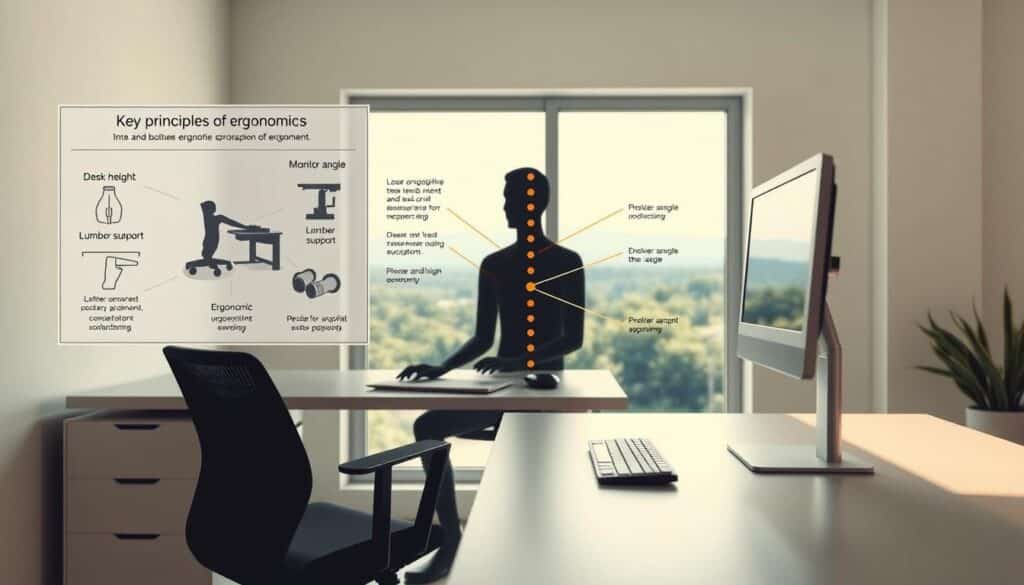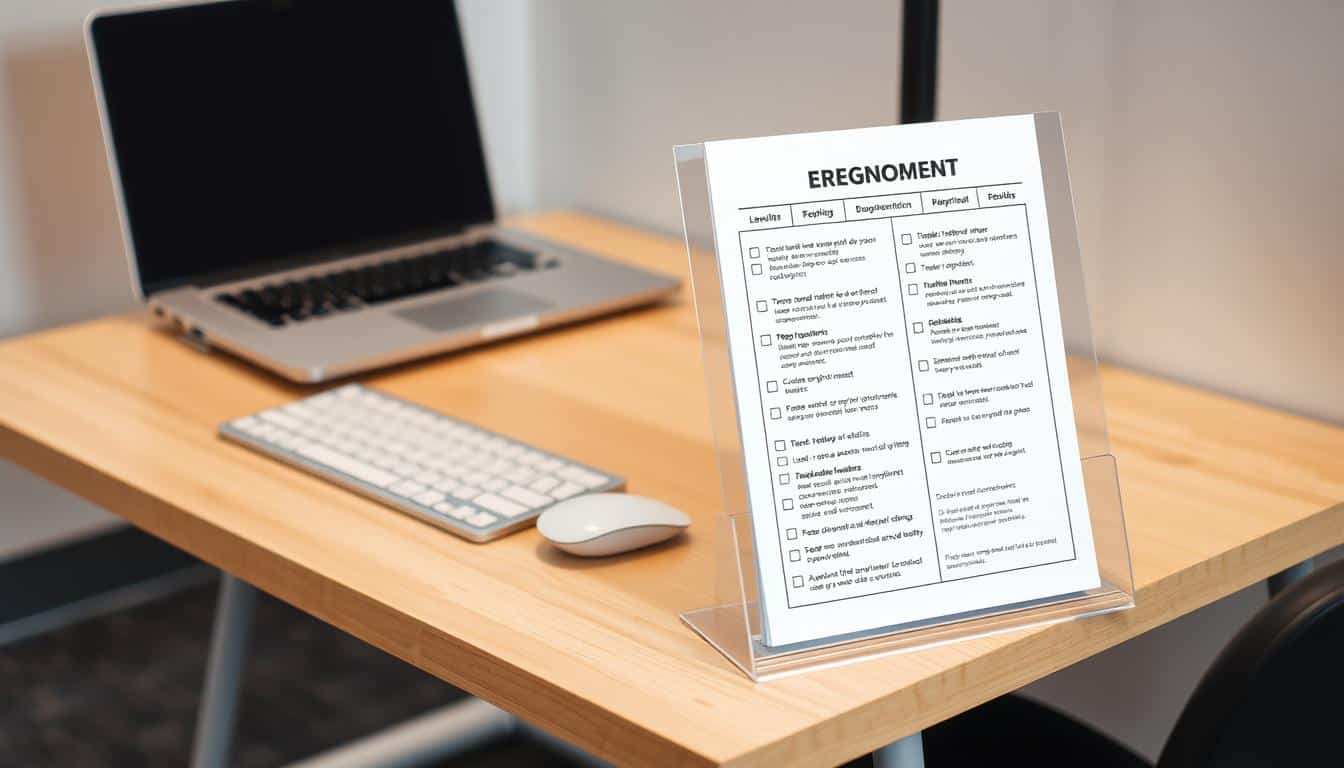In our fast-moving work life, especially for those working from home, organizing your space is key. A good setup with a narrow desk not only uses small spaces well but also boosts comfort and work output. By choosing the right chair, setting your desk at the best height, and placing your monitor correctly, you can make a big difference.
These steps are important for keeping your workflow smooth and helping you stay focused and effective all day. Following these tips for ergonomic office setups will help you craft a workspace that’s both comfy and boosts productivity.
Understanding Ergonomics and Its Importance
Understanding ergonomics is key to making a work area both comfy and efficient. It guides how to shape and set up work spaces. This cuts down on discomfort and injury risk. Such care tackles common problems like back pain and neck strain, often seen in bad work setups.
Good ergonomic designs focus on how we move. They keep our spine aligned and posture right when working. Knowing what each person needs lets us make workstations that help them best. This smart setup boosts work efficiency, making tasks easier and distractions fewer.

Benefits of a Proper Ergonomic Setup
An ergonomic setup brings many key benefits for daily work. It leads to better posture, preventing injuries from bad ergonomics. This also cuts down on musculoskeletal issues often seen in the workspace.
When discomfort and distractions are less, employees can stay focused. This focus boosts the quality and efficiency of their work. Moreover, ergonomic designs help with blood flow and energy. These are crucial in fighting off tiredness from sitting too long.
A workspace with good ergonomics promotes health by encouraging movement. Regular breaks are part of this healthy routine. All these points help create a workspace that values health and productivity equally.
Choosing the Right Chair for Your Narrow Desk
Finding the perfect chair is key to being comfortable during long hours at your desk. There are many ergonomic chairs with different styles. They aim to improve your seating and keep your body in a good position. This is important for your posture and health.
Types of Ergonomic Chairs
Ergonomic chairs come in various types for everyone’s liking:
- Task chairs: Great for short-term use, with basic ergonomic features and adjustability.
- Executive chairs: These offer more support and cushioning, perfect for long hours of work.
- Stools: Good for narrow desks, they offer a simple seat and support a more active work style.
Adjustability and Support Features
Chairs that adjust are crucial for correct ergonomics. They come with different support features:
- Lumbar support: This keeps your spine’s natural shape.
- Height adjustment: It helps your feet stay flat on the ground and keeps your knees right, which is good for your blood flow.
- Armrests: They can move or come off to ease shoulder and wrist stress.
Brands like Steelcase, Herman Miller, and Secretlab make top-notch ergonomic chairs for various needs. Getting the right chair is a big step in improving your work space and staying productive.
Narrow Desk Ergonomic Setup Essentials
Having a comfy and useful workspace starts with choosing the right desk size and height. It’s important to know your space size and how to adjust everything for the best comfort.
Measuring Your Space
Before getting a desk, it’s key to see how much room you have. Measuring workspace size is the first step to making sure your desk fits perfectly. Keep these tips in mind:
- Account for walking space around the desk.
- Consider access to storage and technology.
- Leave space for any additional items, such as filing cabinets or decor.
Choosing the Right Desk Height
The height of your desk is super important for a comfy workspace. A desk height between 28-30 inches is usually best for keeping your elbows at a good angle while typing. If you can change your desk height, use that feature to make it perfect for you. Remember these points:
- Standing options can enhance flexibility and reduce strain.
- Assess chair height to maintain proper alignment with desk height.
- Experiment with various desk heights to find what feels most comfortable for your tasks.
Optimizing Monitor Placement for Comfort
Having your monitor in the right spot is key to staying comfortable during long work hours. You should have your monitor at eye level and about an arm’s length away. This setup helps avoid neck strain. Make sure the top of the screen is at your eye level to see easily and stay comfy.
If you use two monitors, positioning them correctly can boost your work area’s efficiency. Make sure both screens are at the same height and easy to see without moving your head too much. With dual monitors set up right, you can work on multiple tasks comfortably. Consider getting adjustable monitor arms to find the best angle for your screens.
Keyboard and Mouse Positioning for Better Posture
Having your keyboard and mouse set up right matters a lot for comfort. It helps avoid wrist pain and encourages good posture when you’re at the computer for long hours. Your keyboard and mouse should be at the level of your elbows. This way, your wrists stay straight whether you’re typing or using the mouse.
Ergonomic Keyboard Options
An ergonomic keyboard can help you avoid strain. They come with wrist supports and are designed to keep your hands in a natural position. Brands like Logitech and Microsoft make different types to meet various needs. Getting one could make your workspace much more comfortable.
Mouse Placement Techniques
Where you put your mouse is just as crucial for comfort. It should be right next to your keyboard so you don’t have to stretch. Ensure it’s on the same level as your keyboard to switch between typing and using the mouse smoothly. Adjusting this regularly helps keep you comfortable and efficient all day.
Creating a Clutter-Free Workspace
Keeping your workspace clutter-free is key to staying focused and productive. A tidy area helps people perform better, as they’re not distracted by a mess. You can achieve a good-looking and practical desk area with some organization tips.
Organizing Cables and Accessories
Handling your cables and gear is crucial for a tidy desk. Use trays to hide your cables. This makes your space look better and prevents cable knots and accidents. Attach cables behind your desk or furniture to keep things neat.
- Utilize cable ties or clips to group cables together.
- Label cables for easy identification.
- Incorporate under-desk power strips for easy access.
The Role of Desk Organizers
Desk organizers are essential for a neat desk. Assign spots for items you use often. Use boxes, trays, or pegboards for your pens, papers, and more. This keeps your desk clean and your important tools handy.
- Choose organizers that suit your style and needs.
- Opt for multi-functional accessories to save space.
- Regularly assess items and remove those that are no longer needed.
Utilizing Footrests and Other Accessories
Adding footrests and ergonomic accessories can really boost the comfort of your workspace. Footrests help keep your legs in the right spot, which is super helpful if you find your chair too tall. They lessen pressure on your legs, improve blood flow, and are a big plus for short folks.
Benefits of Footrests
Footrests offer many advantages. They can better your posture and cut down on tiredness when you’re working long hours. A footrest can ease lower back stress, making sitting for a while more comfortable. Plus, they often come with adjustable heights and angles to fit what you need.
Additional Accessories to Enhance Comfort
There are more ergonomic tools to up your comfort game. Wrist rests are great for long typing sessions, giving needed support. Then, monitor stands make sure your screen is at eye level, which is good for your neck. Brands like Everlasting Comfort and 3M have lots of products to make your workspace better. Putting money into these can make for a healthier work area.
The Role of Lighting in Your Workspace
Good lighting is key for comfort and work productivity. A bright area not only feels welcoming but also helps avoid tired eyes. Using natural and artificial lights improves your workspace. Getting just the right lights to fit your space can really change things for the better.
Choosing the Right Lighting Solutions
Finding the best lights means knowing what’s out there. Mix general lighting with lights for specific tasks. Sunlight makes you feel better and more awake. If you can, put your desk near a window for some sun. Use a desk lamp that you can dim for detailed work.
Avoiding Glare and Eye Strain
It’s important to keep glare down for comfort. Keep your computer screen away from direct light to stop reflections. Use curtains or blinds to manage sunlight and improve your lighting. This balance helps you work better and keeps your eyes from getting tired.
Stretching and Movement Breaks
Mixing in stretches and movement breaks during your workday can boost comfort and productivity. Moving around every so often reduces muscle tension, lifts your energy, and helps you stay focused. If you work at a desk, aim to get up, stretch, and take a short walk every 30-45 minutes. This helps avoid the discomfort that comes from sitting too long.
Incorporating Stretching into Your Routine
Adding dynamic stretches into your day is a great move for those sitting for hours. Doing simple stretches like neck rolls, shoulder shrugs, and wrist stretches can improve flexibility and circulation. Set reminders on your phone or use a timer for regular stretch breaks. These quick stretches can greatly ease stiffness and better your body’s function.
Using a Standing Desk Option
Standing desks offer more than just less sitting time; they support a more active work life. Switching between sitting and standing boosts concentration and lowers sitting-related risks. If you use a standing desk, shift your weight often and make small movements. This keeps your body active all day.
Maintaining Good Posture Throughout the Day
Having proper alignment is key to feeling good and staying productive. Good posture means your back is straight, shoulders are relaxed, and feet are flat. It’s also important to notice when you get tired to keep up this good form. By regularly checking how you sit or stand, you can avoid pain and make your work area better for your health.
Posture Tips for Sitting
- Keep your back against the chair and use lumbar support.
- Adjust your chair height so your elbows are at a 90-degree angle.
- Ensure your feet rest flat on the ground or on a footrest.
- Center your monitor at eye level to avoid leaning forward.
Signs You Need a Break
Listen to what your body tells you. Knowing when you’re tired can keep you from getting hurt and avoid problems later. Some signs to watch for are:
- Neck stiffness or discomfort.
- Lower back pain after sitting too long.
- Persistent shoulder tightness.
- Eyes feeling sore or strained.
Adjusting Your Workstation for Different Tasks
Making your workstation comfortable means changing it based on what you need to do. When you can easily adjust things like where your chair or monitor sits, you work better. This is true whether you’re typing or doing paperwork. Setting up your chair, monitor, and desk to suit you can help you work smarter and faster.
Task-Specific Ergonomic Adjustments
Changing your workspace for different tasks is all about the details. Some important changes you might make include:
- Adjusting chair height so your elbows are even with the desk for typing.
- Putting the monitor at eye level to avoid neck pain.
- Keeping things you use a lot within easy reach to move smoothly from one task to another.
Creating an Efficient Work Flow
A workspace without clutter helps you stay focused and work better. To keep things working well, you should:
- Only have what you really need on your desk to reduce distractions.
- Use desk organizers to keep tools and materials for certain tasks together.
- Check your workspace setup regularly as your tasks change to keep it working for you.
Common Mistakes to Avoid in Ergonomic Setup
To create a comfortable workspace, avoid these common ergonomic errors. Many folks forget important tweaks that boost comfort and health. Chair adjustments and consistent desk height are especially key.
Ignoring Chair Adjustments
Many people mess up adjusting their chairs. Not setting the right chair height causes discomfort and bad posture. If the chair doesn’t fit right, it can lead to tiredness and pain. Make sure you regularly adjust your chair for the best support.
Overlooking Desk Height Consistency
The height of your workspace is crucial for maintaining a good posture. Not paying attention to desk height can make you slouch or strain. It’s important to keep the desk height consistent, especially when doing different tasks. Always check and adjust your workspace to dodge these ergonomic mistakes.
Conclusion
Having an ergonomic setup is key to a healthy and efficient workspace. It’s not just about looking good. It also helps with productivity and comfort. By following the tips in this guide, you can make a workspace that suits you best. This will help you work better.
Ergonomics is a must for a healthy working environment. By adjusting your chair, desk, monitor, and other items, you can lower discomfort. This boosts your ability to do well at work. Taking time to make your workspace comfortable pays off with better job happiness and performance.
To wrap it up, a workspace that’s good for your body leads to better work and happiness. Taking steps to make these changes is worth it. You’ll see rewards in health, sharper focus, and getting more done every day.



